Original lure development project starts #2
Hello, this is Kamimura from Hitotoki Works!
Development of injection lures that have received positive feedback.
Thank you so much for all the support from everyone <(_ _)>
As was evident from the voices of support in this blog, it seems that there are many people who have realized the power of the "sideways slide."
I'm motivated to further improve the accuracy of the "sideways slide" that I've felt for a long time!!
The first prototype is completed
Mr. Sasaki from Yoshinaga Base, who is based in the same Shizuoka prefecture, is supporting us in developing this lure.
We received a message that Sasaki had completed the first prototype, which he had hand-carved out of plastic, so we went out and tested it out in real fishing.
I just can't contain my excitement!!
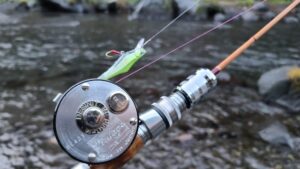
The action of the first model is fairly good, but the sliding action is just a little larger than that of commercially available lures.
Since this is not a completely different genre of action, it requires delicate work to fine-tune the weight, eye, lip position and even body shape on site.
I think it's hard to communicate with myself, who is not good at putting things into words ^_^;
Sorry... <(_ _)>
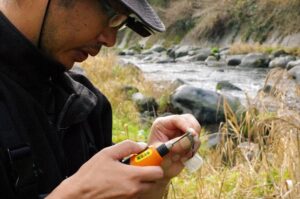
All parts are temporarily fastened to make it easier to repair on site, so care must be taken as they will break if caught.
I kept taking one step at a time and then going back, which made me worry , "Is it even possible to achieve this?"
How to develop a lure
This is going to be a bit off topic, but...
It seems that even major manufacturers rarely have the means to fine-tune their development on-site,
1. Prototype lures based on tester feedback
② The tester personally tests the lure that was delivered to him/her.
3) At a later date, inform the manufacturer of the correction request and make another prototype.
The typical development method is to repeat this process several times.
Here's what I learned from developing my own lure this time.
If the people testing on site and the people who will create the product do not work together to make corrections, subtle nuances will not be conveyed and the number of revisions that can be made will be limited.
Furthermore, it is difficult to convey an idea over the phone.
This was my first time using lures, and with my current skills I was nowhere near the level I had imagined.
However, if you use a lure with a conventional action, it may be possible to achieve the desired action to a certain extent.
I felt that there was a strong possibility that lures made by manufacturers who had passionate fishing enthusiasts like me and who repeatedly tested their lures in-house rather than leaving it up to testers were more likely to be good lures.
Fortunately, in my case, I am extremely lucky to have someone nearby who can provide me with extremely skilled development support.
If you're far away, there's a limit to the number of tests you can take!
The shortcomings of the first model are highlighted
After repeated on-site testing, the shortcomings of the first model became apparent.
The body is tall and has strong buoyancy, making it easy to float, and when the lure lies on its side, there is a lot of resistance which makes it difficult to slide sideways.
Furthermore, the twitch to apply action is a little heavy.
So I decided to start by looking at the body shape.
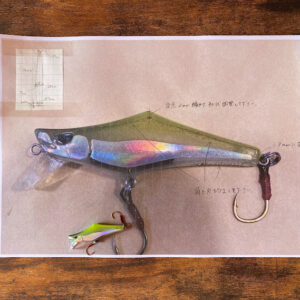
The second unit has a slim shape
In order to eliminate the issues with the first unit, the height of the second unit in the image below has been reduced by 2 mm, and the upper corners have been rounded.
The overall length remains unchanged at approximately 51.5 mm.
After the second and third actual fishing tests, the lip angle and size became as shown in the image.
*The photo shows Unit 2 after repainting.
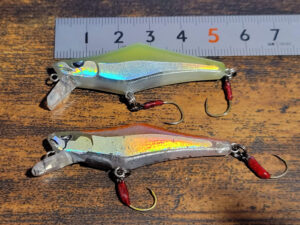
The width has also been extensively remodeled, making it much slimmer.
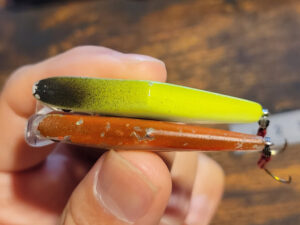
The photo below shows the first paint job of Unit 2 during testing.

We pursue the ideal action by shaving the body on site and finding the optimum balance between the lip, eye position, and weight.

After the third test, we were finally able to get close to the ideal action.
A sideways sliding action that you've never seen before and can't find in any commercially available product.
It's like an underwater dog walk!!
This sample model will then be digitized and we will move on to the next stage of creating Unit 3 using machine cutting (until now, this has been done by hand).
It might be going better than I thought!!
At the time, we never imagined that an incident would occur during the fourth test of Unit 3...
